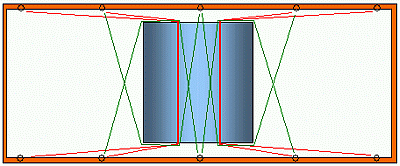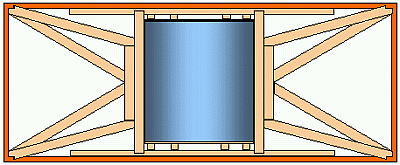The residual longitudinal securing effort of 24 · 0.7 · 9.81 = 165 kN is achieved by lashings (red in Figure 35) and by pressure elements to the end walls and corner posts. Only four of the lashings are loaded simultaneously to fore or aft. The pressure elements consist of four timbers of 15 x 15 cm cross-section, secured against falling loose and against buckling due to their length (the latter not shown in Figure 36).
The residual transverse securing effort of 24 · 0.5 · 9.81 = 118 kN is achieved by lashings (green in Figure 35) and by pressure elements of four timbers of 12 x 12 cm cross-section to each side. Only three securing points are loaded simultaneously in the transverse direction.

Figure 35: Longitudinal and transverse lashing of the coil

Figure 36: Longitudinal and transverse shoring of the coil
The arrangement is checked by a balance:
| Longitudinally: | 1 · 9.81 · 24 ≤ 0.3 · 24 · 9.81 + (4 · 10 + 4 · 225 · 0.3) / 1.5 |
| 235 ≤ 71 + 207 |
| 235 = 278 | Balance is well met! |
| Transversely: | 0.8 · 9.81 · 24 ≤ 0.3 · 24 · 9.81 + (3 · 10 + 4 · 144 · 0.3) / 1.5 |
| 188 ≤ 71 + 135 |
| 188 < 206 | Balance is met! |
The securing effort is increased again with regard to the previous example. In particular the distribution of forces from transverse braces onto the container walls requires carefulness. Attention should be paid to introduce the load into the lower third of the side walls. The transverse lashings shall provide some relief to the side walls.
It stands out in all examples that the lashings, due to the low strength of the securing points, contribute only little to the overall securing arrangement. Nevertheless, they should be applied because they may, if given a good pre-tension, disburden the weaker end walls of the container and have an overall stabilising effect on the securing arrangement.